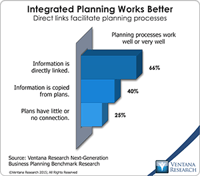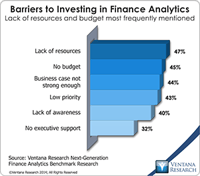Ventana Research recently released the results of our Next-Generation Business Planning benchmark research. Business planning encompasses all of the forward-looking activities in which companies routinely engage. The research examined 11 of the most common types of enterprise planning: capital, demand, marketing, project, sales and operations, strategic, supply chain and workforce planning, as well as sales forecasting and corporate and IT budgeting. We also aggregated the results to draw...
Read More
Topics:
Big Data,
Planning,
Predictive Analytics,
Sales,
Social Media,
Human Capital Management,
Marketing,
Office of Finance,
Operational Performance Management (OPM),
Reporting,
Budgeting,
Controller,
Business Analytics,
Cloud Computing,
In-memory,
Business Performance Management (BPM),
CFO,
Customer Performance Management (CPM),
Financial Performance Management (FPM),
Sales Performance Management (SPM),
Supply Chain,
Workforce Performance Management (WPM),
capital spending,
demand management,
Financial Performance Management,
financial reporting,
FPM,
Integrated Business Planning,
S&OP
When it comes to making a business case for software investments, many people fail to recognize that the case itself is just one part of what amounts to an internal sales and marketing effort that they must perform well to be successful. Focusing only on the numbers and assumptions in a spreadsheet is not enough. Making a successful business case requires an understanding of the audience’s perspective and motivations. Since the individuals who will review the business case may not be...
Read More
Topics:
Planning,
ERP,
Office of Finance,
Operational Performance Management (OPM),
Research,
budgeting and planning,
ROI,
Analytics,
Business Performance Management (BPM),
CFO,
CRM,
Customer Performance Management (CPM),
Financial Performance Management (FPM),
Sales Performance Management (SPM),
Supply Chain Performance Management (SCPM),
business plan,
capital spending,
Financial Performance Management,
FPM,
SCM,
Software
Effective capital planning and capital investment are vital to a company’s long-term success. The choices a company makes – how much to invest and in which facilities or projects – have a profound effect on its long-term success. For that reason, companies take pains to ensure that these decisions support their long-term strategies and are made as rationally as possible. Because Ventana Research is frequently involved in software acquisition discussions, return on investment is a topic we...
Read More
Topics:
Planning,
Office of Finance,
Reporting,
Business Analytics,
Business Performance Management (BPM),
finance,
Financial Performance Management (FPM),
capital budget,
capital spending,
FPM
In today’s economy, all companies are contending with a dynamic business environment characterized by volatile commodity prices and exchange rates, a shaky global financial system and slow growth in many countries. Many of them rely heavily on desktop spreadsheets to support the data collection and analysis related to their capital-asset planning. However, spreadsheets have inherent limitations that make them the wrong choice.
Read More
Topics:
Big Data,
Planning,
SAP,
Office of Finance,
Operational Performance Management (OPM),
Planview,
Budgeting,
contingency,
IBM,
Oracle,
Business Performance Management (BPM),
Financial Performance Management (FPM),
agile,
capital spending













